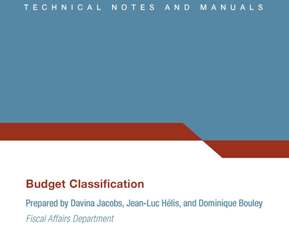Posted by Davina Jacobs

Why should budget and treasury officials see the “budget classification” as one of their most important tools? What exactly is the budget classification? A new IMF Technical Note and Manual on Budget Classification (TNM/09/06) (attached below) prepared by Davina Jacobs, Jean-Luc Hélis and Dominique Bouley of the Fiscal Affairs Department addresses the following main issues:
• Why is a budget classification system important?
• What are the main features of a sound budget classification system?
• How should a budget classification system be structured?
• What is the relationship between budget classification and the chart of accounts (COA)?
• What are the pre-conditions for successful implementation of a new budget classification system?
• What are likely to be the critical steps and milestones in the reform of a budget classification?
• First, the budget classification is one of the fundamental building blocks of a sound budget management system, as it determines the manner in which budgetary data is classified and presented, and as such has a direct impact on the transparency and coherence of the budget as a primary policy instrument of government. In countries where the budget nomenclature is weak, upgrading the budget classification system should itself be considered a basic step—indeed a pre-condition—before embarking on other reforms of the public financial management (PFM) system.
• Second, a budget classification system provides a normative framework for both policy decision-making and accountability. Classifying expenditures and revenues correctly is important for: (1) policy formulation and performance analysis; (2) allocating resources efficiently among sectors; (3) ensuring compliance with the budgetary resources approved by the legislature; and (4) day-to-day administration of the budget. A sound budget classification scheme should also make it possible, for example, to determine the budget lines linked to poverty-reducing expenditure.
To make use of this functionality, a sound budget classification system should at a minimum comprise:
• a classification of revenues; and
• an administrative, economic, and functional classifications of expenditures.
Many countries use additional classification schemes to enhance transparency and accountability, and to better manage their finances (such as classification by geographical location, by beneficiaries of government transfers and subsidies, by source of financing, and by program classification). However, it is necessary to be careful in expanding the different types of classifications to be used. Such an expansion could possibly lead to unreliable information, due to the complexity of the budget nomenclature. It also requires more capacity and resources (both accounting staff and IT systems) to generate the required information and maintain the system.
Depending on the scope of the reform, and the conditions prevailing in a country, a reform of the budget classification can be a lengthy process, in particular to achieve full integration of the budget classification and the chart of accounts. The chart of accounts refers to the accounting classification (or financial reporting classification) that is primarily used for the administration, recording, and reporting on financial transactions. Changes are likely to be required in the legal and regulatory framework for the budget, the government’s financial management and information system, and training and outreach programs to raise awareness and upgrade the skills of staff in the ministry of finance and other government entities.







